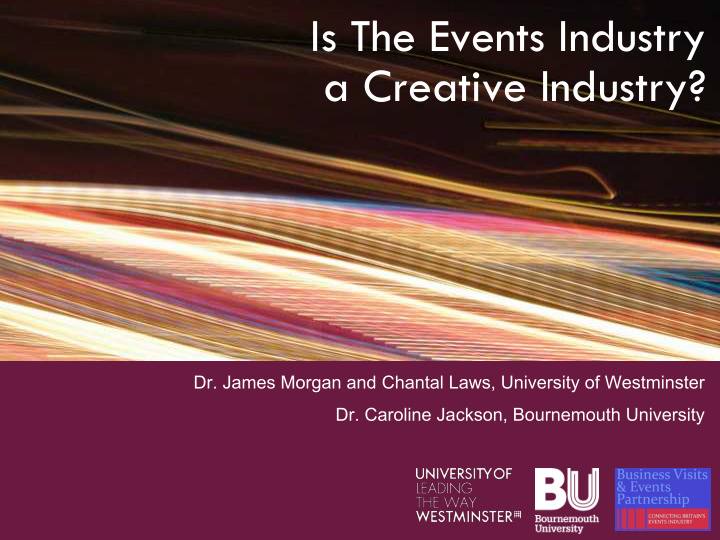



Is The Events Industry a Creative Industry? Dr. James Morgan and Chantal Laws, University of Westminster Dr. Caroline Jackson, Bournemouth University
Background to our project – Events Industry SIC classification – what is it? – How does it fit into the wider world? – Close relationships to Advertising & Marketing, Music, Tourism and Hospitality SIC s creates issues of ownership and sovereignty – Sector push back – Potential impacts on related activity – events management education
Critiques – Validity of creativity as a policy concept – Exclusivity of arts and culture – Prominence of IT and knowledge economy domains – Pragmatism of mapping categories as key to accessing Treasury funds – Privileging creativity as an agent of economic and social transformation e.g. Florida creative class – Pratt (2005) standard industry codes are not fit for purpose: “For policy makers it is as if suddenly a successful new industry has arrived from nowhere, although the constituent industries are widely recognised [having been] previously perceived as part of the state or as peripheral to the “real economies” (p. 19)
Clearer Industry Recognition: the BVEP Proposal • Research the creative intensity of the events industry per business type and job 1 role type • To have the sector recognised by the DCMS and CIC as a Creative Industry 2 • Realign SIC and SOC codes for international classification code 3 negotiations in 2017
SJS Consultancy Services
What is Creative Intensity? – Range of models developed with various iterations – Intensity is measured in the job role – What % of the role is creative – Concerns over a common definition used to describe creativity – Challenge of answering question “What is creativity in events sector?”
The Research Method – Freeman (2008) standardised methodology – Based on sectoral functions (business types based on creative, mixed-creative or non-creative) – Explicitly event sector based – Breakdown of roles within those business units (large, medium, small units) – Measurement of creative intensity of each role – 14-18 month project
Challenges – Lack of coherence in existing research – Issues with sector measurement methodologies: e.g. design “no codes available” – 2008-2012 creative industries are the second highest percentage change in terms of GVA (15.6%) – Pre-millennial thinking – “The DCMS mapping of the UK creative industries played a critical formative role in establishing international policy discourse for what the creative industries are, how to define them and what their wider significance constitutes (Flew, 2011: 10)
Evaluation of the Method: fit for purpose? – The definition should be wide enough to encompass the creative tasks in the sector – Once research has been completed there needs to be an evaluation of: – Definition of creativity for events sector – Various types of creative intensity (task/ frequency based) – Frequency of creative tasks – Appropriateness of standard classification
Peer Discussion – Should events and organisations allied to events be defined/recognised as part of the creative industries in the UK? – What are the available research methodologies that could assist with the current criteria of creative intensity of the people working in the sector? – What are the possibilities and limitations of such approaches? – What are the implications for events education e.g. being in a Business School? – Could it inform the QAA subject benchmark reviews and how?
Recommend
More recommend